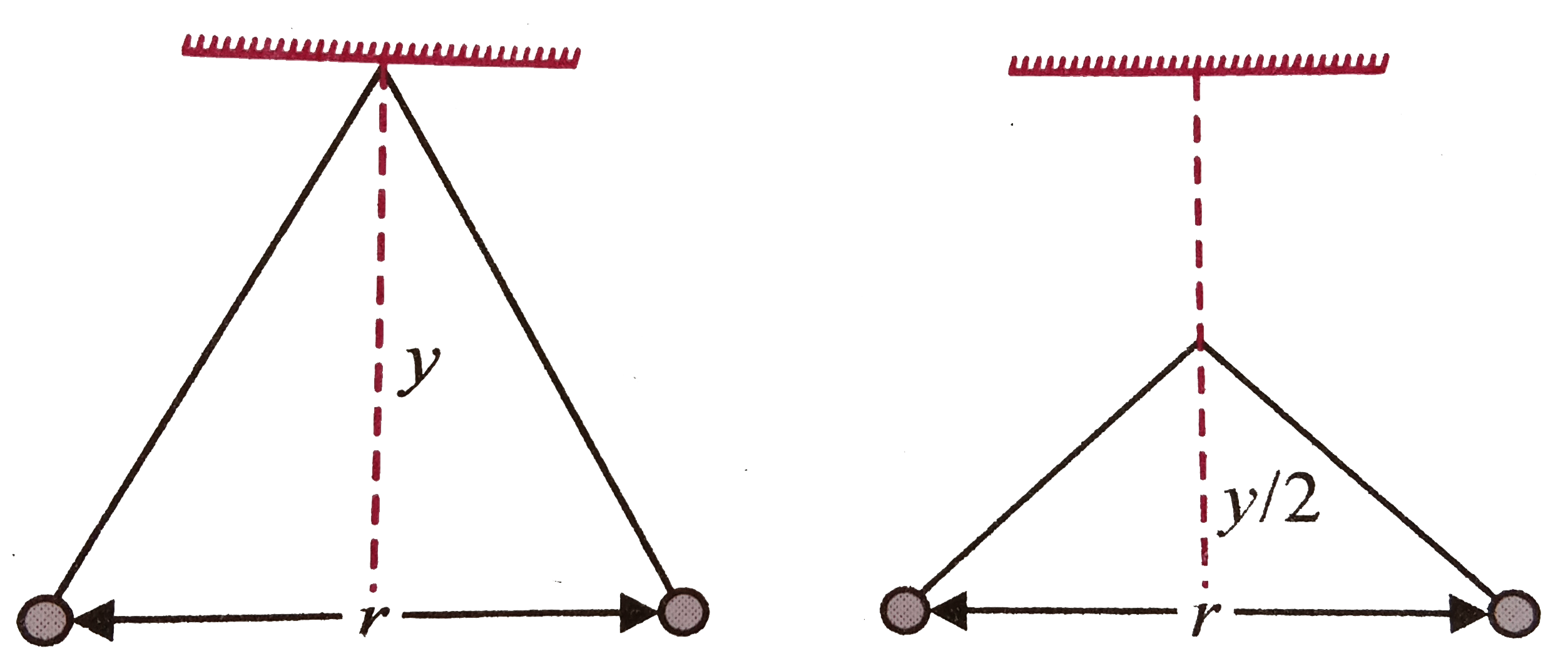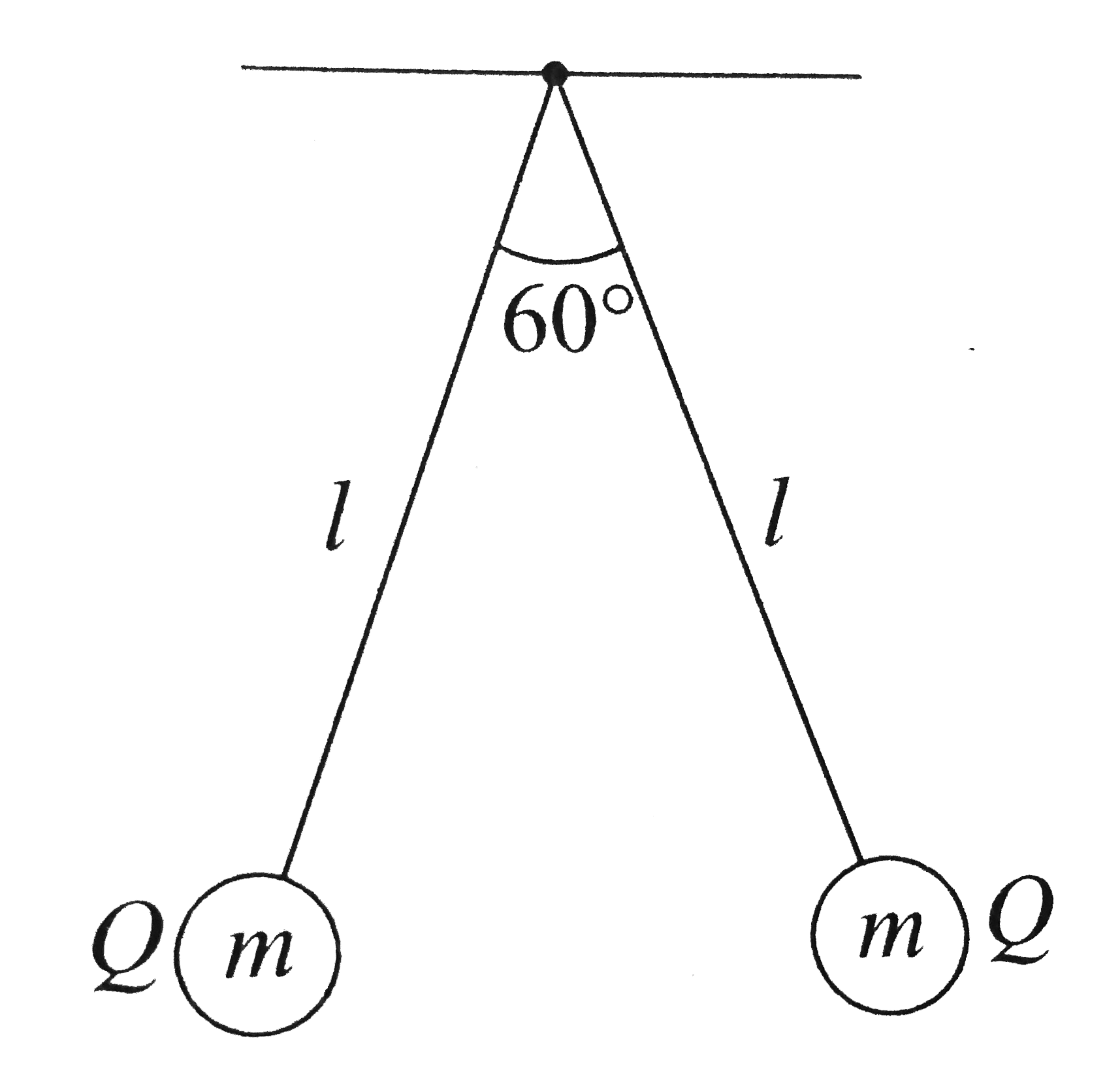Two small spheres, each having a mass of 20 g, are suspended form a common point by two insulating strings of length 40 cm each. The spheres are identically charged and the speration between the balls at equilibrium is found to be 4 cm . Find the charge on each sphere.
To solve the problem step by step, we will follow the outlined approach:
Step 1: Understand the Problem
We have two small spheres, each with a mass of 20 g (0.02 kg), suspended by strings of length 40 cm (0.4 m). The spheres are charged and repel each other, resulting in a separation of 4 cm (0.04 m) at equilibrium.
Step 2: Identify Forces Acting on the Spheres
At equilibrium, each sphere experiences:
1. Gravitational force acting downwards: Fg=mg
2. Tension in the string acting along the string
3. Electrostatic force due to the repulsion between the charged spheres
Step 3: Set Up the Geometry
Let:
- T be the tension in the string
- θ be the angle between the string and the vertical line
From the geometry:
- The horizontal distance from the vertical line to each sphere is 4 cm2=2 cm=0.02 m.
- The length of the string is L=0.4 m.
Using the Pythagorean theorem, we can find cosθ and sinθ:
- cosθ=adjacenthypotenuse=0.40.4=1
- sinθ=oppositehypotenuse=0.020.4=0.05
Step 4: Write Equations for Forces
1. In the vertical direction (y-axis):
Tcosθ=mg
(Equation 1)
2. In the horizontal direction (x-axis):
Tsinθ=Fe
(Equation 2)
Where Fe is the electrostatic force given by Coulomb's law:
Fe=kQ2r2
with k=9×109N m2/C2 and r=0.04m.
Step 5: Relate the Two Equations
Dividing Equation 2 by Equation 1:
TsinθTcosθ=Femg
This simplifies to:
tanθ=Femg
Step 6: Substitute for Fe
Substituting Fe:
tanθ=kQ2r2mg
Step 7: Calculate tanθ
From the geometry, we can find tanθ:
tanθ=0.02√0.42−0.022=0.02√0.16−0.0004=0.02√0.1596≈0.05
Step 8: Substitute Values
Substituting into the equation:
0.05=9×109Q2(0.04)20.02×9.8
Step 9: Solve for Q2
Rearranging gives:
Q2=0.05×0.02×9.8×(0.04)29×109
Calculating:
Q2=0.05×0.02×9.8×0.00169×109
Q2=0.00015689×109≈1.742×10−14
Step 10: Take the Square Root
Finally, take the square root to find Q:
Q≈√1.742×10−14≈4.123×10−7C
Final Answer
The charge on each sphere is approximately 4.123×10−7C.
We have two small spheres, each with a mass of 20 g (0.02 kg), suspended by strings of length 40 cm (0.4 m). The spheres are charged and repel each other, resulting in a separation of 4 cm (0.04 m) at equilibrium.
At equilibrium, each sphere experiences:
1. Gravitational force acting downwards: Fg=mg
2. Tension in the string acting along the string
3. Electrostatic force due to the repulsion between the charged spheres
Let:
- T be the tension in the string
- θ be the angle between the string and the vertical line
- The horizontal distance from the vertical line to each sphere is 4 cm2=2 cm=0.02 m.
- The length of the string is L=0.4 m.
- cosθ=adjacenthypotenuse=0.40.4=1
- sinθ=oppositehypotenuse=0.020.4=0.05
1. In the vertical direction (y-axis):
Tcosθ=mg
(Equation 1)
Tsinθ=Fe
(Equation 2)
Fe=kQ2r2
with k=9×109N m2/C2 and r=0.04m.
Dividing Equation 2 by Equation 1:
TsinθTcosθ=Femg
This simplifies to:
tanθ=Femg
Substituting Fe:
tanθ=kQ2r2mg
From the geometry, we can find tanθ:
tanθ=0.02√0.42−0.022=0.02√0.16−0.0004=0.02√0.1596≈0.05
Substituting into the equation:
0.05=9×109Q2(0.04)20.02×9.8
Rearranging gives:
Q2=0.05×0.02×9.8×(0.04)29×109
Q2=0.05×0.02×9.8×0.00169×109
Q2=0.00015689×109≈1.742×10−14
Finally, take the square root to find Q:
Q≈√1.742×10−14≈4.123×10−7C
The charge on each sphere is approximately 4.123×10−7C.
Topper's Solved these Questions
- BOOK - HC VERMA ENGLISHCHAPTER - ELECTRIC FIELD AND POTENTIALEXERCISE - question for short answer14videos
ELECTRIC FIELD AND POTENTIAL
- BOOK - HC VERMA ENGLISHCHAPTER - ELECTRIC FIELD AND POTENTIALEXERCISE - Objective 19videos
ELECTRIC FIELD AND POTENTIAL
- BOOK - HC VERMA ENGLISHCHAPTER - ELECTRIC FIELD AND POTENTIALEXERCISE - worked out Examples19videos
ELECTRIC FIELD AND POTENTIAL
- BOOK - HC VERMA ENGLISHCHAPTER - ELECTRIC CURRENT THROUGH GASESEXERCISE - Short answer6videos
ELECTRIC CURRENT THROUGH GASES
- BOOK - HC VERMA ENGLISHCHAPTER - ELECTROMAGNETIC INDUCTIONEXERCISE - Questions for short answer9videos
ELECTROMAGNETIC INDUCTION
Similar Questions
Two identical balls , each having a charge q and mass m , are suspended from a common point by two insultating strings each of length L. The balls are held at a separation x and then released. Find
(a) the electric force on each ball
(b) the component of the resultant force on a ball along and perpendicular to string
(c ) the tension in the string
(d) the acceleration of one of the balls. Consider the situation only for the instant just after the release.View SolutionTwo identical pith balls, each carrying charge q, are suspended from a common point by two strings of equal length l. Find the mass of each ball if the angle between the strings is 2θ in equilibrium.
View SolutionTwo indentical pith balls, each carrying charge q, are suspended from a common point by two strings of equal length l. Find the mass of each ball if the angle between the strings is 2θ in equilibrium.
View SolutionTwo path balls carrying equal charges are suspended from a common point by strings of equal length, the strings are rightly clamped at half the height. The equilibrium separation between the balls, now becomes :
 View Solution
View SolutionTwo indentical balls, each having a charge of 2.00×10−7C and a mass of 100g , are suspended from a common point by two insulating strings each 50 cm long. The balls are held at a separation 5.0cm apart and then released. Find (a) the electric force on one of the charged balls (b) the components of the resultant force on it along and perpendicular to the string (c) the tension is the string (d) the acceleration of one of the balls. Answers are to be obtained just after the release.
View SolutionThree paricles, each of mass m and carrying a charge q each, are suspended from a common pointby insulating massless strings each of length L. If the particles are in equilibrium and are located at the corners of an equilateral triangle of side a, calculate the charge q on each particle. Assume L>>a.
View SolutionTwo identical balls each having a density ρ are suspended from as common point by two insulating strings of equal length. Both the balls have equal mass and charge. In equilibrium each string makes an angle θ with vertical. Now, both the balls are immersed in a liquid. As a result the angle θ does not change. The density of the liquid is σ. Find the dielectric constant of the liquid.
View SolutionTwo identical balls each having a density ρ are suspended from as common point by two insulating strings of equal length. Both the balls have equal mass and charge. In equilibrium each string makes an angle θ with vertical. Now, both the balls are immersed in a liquid. As a result the angle θ does not change. The density of the liquid is σ. Find the dielectric constant of the liquid.
View SolutionTwo identical pith balls are charged by rubbing against each other. They are suspended from a horizontal rod through two strings of length 20 cm each, the separation between the suspension points being 5 cm. in equilibrium, the separation between the balls in 3 cm. Find the mass of each ball and the tension in the strings. the charge on each ball of a magnitude 2.0×10−8C.
View SolutionTwo small balls, each having equal positive charge Q are suspended by two insulationg strings of equal length l from a hook fixed to a stand. It mass of each ball =m and total angle between the two strings is 60∘m, then find the charge on each ball.
 View Solution
View Solution

